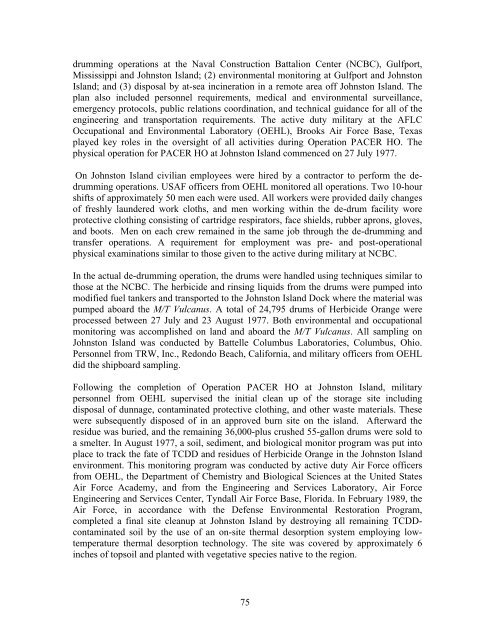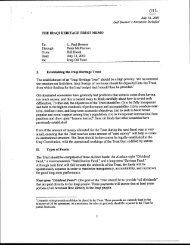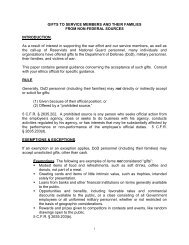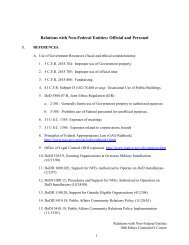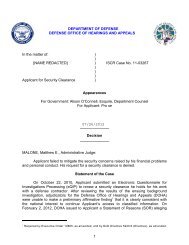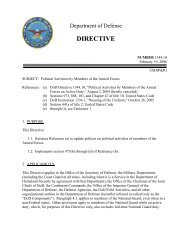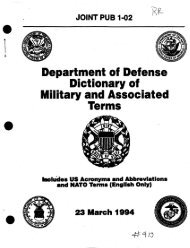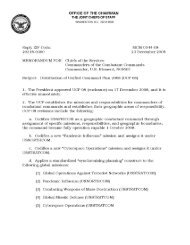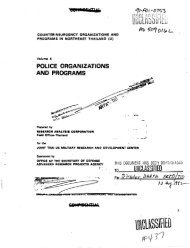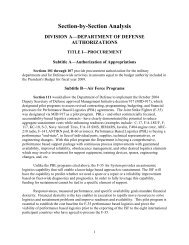dod tactical herbicide sites - United States Department of Defense
dod tactical herbicide sites - United States Department of Defense
dod tactical herbicide sites - United States Department of Defense
Create successful ePaper yourself
Turn your PDF publications into a flip-book with our unique Google optimized e-Paper software.
drumming operations at the Naval Construction Battalion Center (NCBC), Gulfport,Mississippi and Johnston Island; (2) environmental monitoring at Gulfport and JohnstonIsland; and (3) disposal by at-sea incineration in a remote area <strong>of</strong>f Johnston Island. Theplan also included personnel requirements, medical and environmental surveillance,emergency protocols, public relations coordination, and technical guidance for all <strong>of</strong> theengineering and transportation requirements. The active duty military at the AFLCOccupational and Environmental Laboratory (OEHL), Brooks Air Force Base, Texasplayed key roles in the oversight <strong>of</strong> all activities during Operation PACER HO. Thephysical operation for PACER HO at Johnston Island commenced on 27 July 1977.On Johnston Island civilian employees were hired by a contractor to perform the dedrummingoperations. USAF <strong>of</strong>ficers from OEHL monitored all operations. Two 10-hourshifts <strong>of</strong> approximately 50 men each were used. All workers were provided daily changes<strong>of</strong> freshly laundered work cloths, and men working within the de-drum facility woreprotective clothing consisting <strong>of</strong> cartridge respirators, face shields, rubber aprons, gloves,and boots. Men on each crew remained in the same job through the de-drumming andtransfer operations. A requirement for employment was pre- and post-operationalphysical examinations similar to those given to the active during military at NCBC.In the actual de-drumming operation, the drums were handled using techniques similar tothose at the NCBC. The <strong>herbicide</strong> and rinsing liquids from the drums were pumped intomodified fuel tankers and transported to the Johnston Island Dock where the material waspumped aboard the M/T Vulcanus. A total <strong>of</strong> 24,795 drums <strong>of</strong> Herbicide Orange wereprocessed between 27 July and 23 August 1977. Both environmental and occupationalmonitoring was accomplished on land and aboard the M/T Vulcanus. All sampling onJohnston Island was conducted by Battelle Columbus Laboratories, Columbus, Ohio.Personnel from TRW, Inc., Redondo Beach, California, and military <strong>of</strong>ficers from OEHLdid the shipboard sampling.Following the completion <strong>of</strong> Operation PACER HO at Johnston Island, militarypersonnel from OEHL supervised the initial clean up <strong>of</strong> the storage site includingdisposal <strong>of</strong> dunnage, contaminated protective clothing, and other waste materials. Thesewere subsequently disposed <strong>of</strong> in an approved burn site on the island. Afterward theresidue was buried, and the remaining 36,000-plus crushed 55-gallon drums were sold toa smelter. In August 1977, a soil, sediment, and biological monitor program was put intoplace to track the fate <strong>of</strong> TCDD and residues <strong>of</strong> Herbicide Orange in the Johnston Islandenvironment. This monitoring program was conducted by active duty Air Force <strong>of</strong>ficersfrom OEHL, the <strong>Department</strong> <strong>of</strong> Chemistry and Biological Sciences at the <strong>United</strong> <strong>States</strong>Air Force Academy, and from the Engineering and Services Laboratory, Air ForceEngineering and Services Center, Tyndall Air Force Base, Florida. In February 1989, theAir Force, in accordance with the <strong>Defense</strong> Environmental Restoration Program,completed a final site cleanup at Johnston Island by destroying all remaining TCDDcontaminatedsoil by the use <strong>of</strong> an on-site thermal desorption system employing lowtemperaturethermal desorption technology. The site was covered by approximately 6inches <strong>of</strong> topsoil and planted with vegetative species native to the region.75


